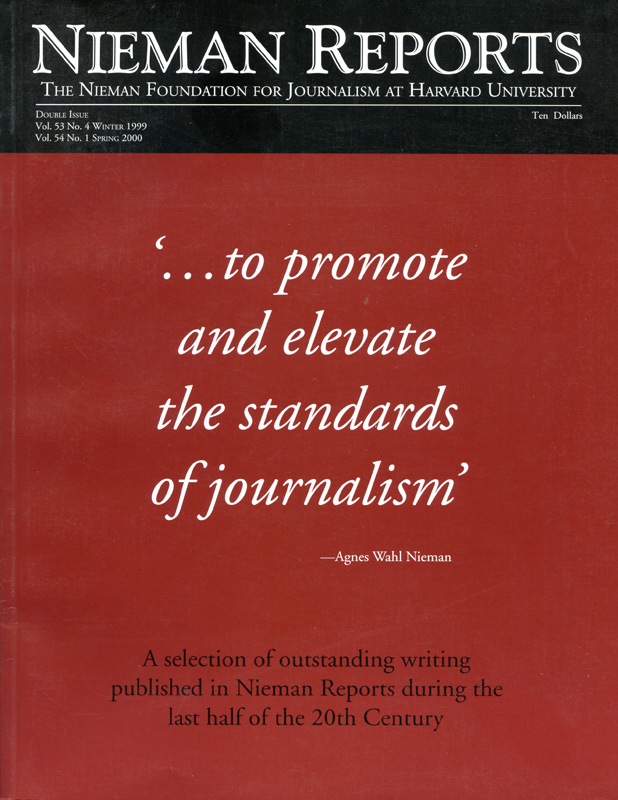In the spring of 1999, Nieman Curator Bill Kovach opened the second Watchdog Journalism Conference by voicing concern about the possible consequences of shifting relationships among sources and journalists. He said, “This year, the Clinton/Lewinsky story has highlighted the extraordinary degree to which American reporting, especially in Washington, has put itself in a position to be manipulated by those who have a vital interest in the outcome of the story. One impact of the new technology has been to shift the power relationship toward the sources of the information and away from the news organizations that cover them. Increasingly, sources usurp the gatekeeping role of the journalist to dictate the terms of the interaction, the conditions under which the information will be released, and the timing of publication. This is a power shift so dramatic that I believe it can destroy journalistic independence, and certainly it changes the whole notion of journalistic distance.”
How reporters work with sources and handle the information that sources relay to them has long been a topic of concern among journalists. In 1958, Alfred Friendly, Managing Editor of The Washington Post, wrote a memo to his staff about what many believed was the most vexing problem of the news. That problem: stories that could not be attributed to their source(s).
Less than a quarter century later, The Washington Post failed to adhere to Friendly’s advice and published “Jimmy’s World,” the story of a heroin-addicted boy who didn’t exist. In examining what happened, Clark R. Mollenhoff (NF’50) explored the myths about sources that developed in the wake of that newspaper’s Watergate reporting.
Gene Foreman, Managing Editor of The Philadelphia Inquirer, proposed guidelines to help reporters figure out when a source can remain anonymous and the story credible. “I am convinced,” he wrote in 1984, “that by needlessly resorting to unnamed sources, we undermine our cherished credibility and dilute our effectiveness as an institution.”
Nieman Curator Howard Simons visited in these pages the topic of government secrecy and the complex questions posed to reporters and editors when secrets are discovered or when officials ask that secrets be withheld.
At the spring 1999 Watchdog Journalism Conference, reporters devoted much attention to their relationships with sources. Among questions they addressed were: How are these relationships established? How can and should they be maintained during the course of reporting a story? Where should reporters draw the line in terms of their interactions with sources? Can reporters get too close to their sources? How can a story not be compromised by a source’s own agenda? New York Daily News reporter William Rashbaum acknowledged that “the best work I’ve ever done is when I’ve been completely shut out by the agency or institution I’m covering…. Because when you are shut out, you just have to work harder and you have to dig harder….”
How reporters work with sources and handle the information that sources relay to them has long been a topic of concern among journalists. In 1958, Alfred Friendly, Managing Editor of The Washington Post, wrote a memo to his staff about what many believed was the most vexing problem of the news. That problem: stories that could not be attributed to their source(s).
Less than a quarter century later, The Washington Post failed to adhere to Friendly’s advice and published “Jimmy’s World,” the story of a heroin-addicted boy who didn’t exist. In examining what happened, Clark R. Mollenhoff (NF’50) explored the myths about sources that developed in the wake of that newspaper’s Watergate reporting.
Gene Foreman, Managing Editor of The Philadelphia Inquirer, proposed guidelines to help reporters figure out when a source can remain anonymous and the story credible. “I am convinced,” he wrote in 1984, “that by needlessly resorting to unnamed sources, we undermine our cherished credibility and dilute our effectiveness as an institution.”
Nieman Curator Howard Simons visited in these pages the topic of government secrecy and the complex questions posed to reporters and editors when secrets are discovered or when officials ask that secrets be withheld.
At the spring 1999 Watchdog Journalism Conference, reporters devoted much attention to their relationships with sources. Among questions they addressed were: How are these relationships established? How can and should they be maintained during the course of reporting a story? Where should reporters draw the line in terms of their interactions with sources? Can reporters get too close to their sources? How can a story not be compromised by a source’s own agenda? New York Daily News reporter William Rashbaum acknowledged that “the best work I’ve ever done is when I’ve been completely shut out by the agency or institution I’m covering…. Because when you are shut out, you just have to work harder and you have to dig harder….”



